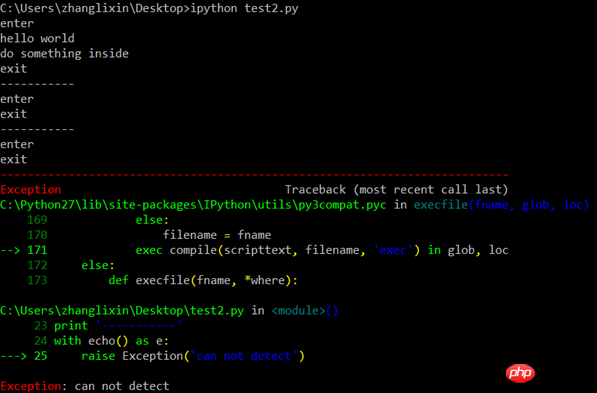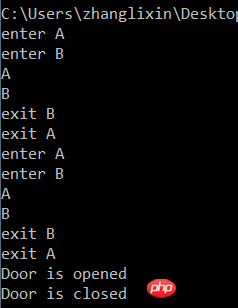 Backend Development
Backend Development
 Python Tutorial
Python Tutorial
 Detailed explanation of the usage examples of with and contextlib in Python basic tutorial
Detailed explanation of the usage examples of with and contextlib in Python basic tutorial
Detailed explanation of the usage examples of with and contextlib in Python basic tutorial
This article mainly introduces the usage of with and contextlib in Python. It analyzes the functions, usage methods and related precautions of with and contextlib in detail in the form of examples. Friends in need can refer to it
The examples in this article describe the usage of with and contextlib in Python. Share it with everyone for your reference, the details are as follows:
In the normal coding process, the with scenario that is often used is (opening a file for file processing, and then implicitly executing the closing of the file handle, which is also suitable for sockets) Classes, these classes provide support for with):
with file('test.py','r') as f : print f.readline()
The role of with is similar to try...finally..., providing a context mechanism, To apply the with statement, the class must provide two built-in functions __enter__ and __exit__. The former is executed before the main code is executed, and the latter is executed after the main code is executed. The variables after as are returned in the __enter__ function. Through the following code snippet and comments, you can clearly understand the usage of __enter__ and __exit__:
##
#!encoding:utf-8
class echo :
def output(self) :
print 'hello world'
def __enter__(self):
print 'enter'
return self #返回自身实例,当然也可以返回任何希望返回的东西
def __exit__(self, exception_type, exception_value, exception_traceback):
#若发生异常,会在这里捕捉到,可以进行异常处理
print 'exit'
#如果改__exit__可以处理改异常则通过返回True告知该异常不必传播,否则返回False
if exception_type == ValueError :
return True
else:
return False
with echo() as e:
e.output()
print 'do something inside'
print '-----------'
with echo() as e:
raise ValueError('value error')
print '-----------'
with echo() as e:
raise Exception('can not detect') 
from contextlib import contextmanager
@contextmanager
def make_context() :
print 'enter'
try :
yield {}
except RuntimeError, err :
print 'error' , err
finally :
print 'exit'
with make_context() as value :
print valuefrom contextlib import contextmanager
from contextlib import nested
from contextlib import closing
@contextmanager
def make_context(name) :
print 'enter', name
yield name
print 'exit', name
with nested(make_context('A'), make_context('B')) as (a, b) :
print a
print b
with make_context('A') as a, make_context('B') as b :
print a
print b
class Door(object) :
def open(self) :
print 'Door is opened'
def close(self) :
print 'Door is closed'
with closing(Door()) as door :
door.open()
Summary: Python has many Powerful features, because we are usually accustomed to some previous programming habits of C++ or Java, we often overlook these good mechanisms. Therefore, we must learn to use these python features to make the python programs we write more like python.
The above is the detailed content of Detailed explanation of the usage examples of with and contextlib in Python basic tutorial. For more information, please follow other related articles on the PHP Chinese website!

Hot AI Tools

Undresser.AI Undress
AI-powered app for creating realistic nude photos

AI Clothes Remover
Online AI tool for removing clothes from photos.

Undress AI Tool
Undress images for free

Clothoff.io
AI clothes remover

Video Face Swap
Swap faces in any video effortlessly with our completely free AI face swap tool!

Hot Article

Hot Tools

Notepad++7.3.1
Easy-to-use and free code editor

SublimeText3 Chinese version
Chinese version, very easy to use

Zend Studio 13.0.1
Powerful PHP integrated development environment

Dreamweaver CS6
Visual web development tools

SublimeText3 Mac version
God-level code editing software (SublimeText3)

Hot Topics
 1662
1662
 14
14
 1419
1419
 52
52
 1311
1311
 25
25
 1261
1261
 29
29
 1234
1234
 24
24
 PHP and Python: Different Paradigms Explained
Apr 18, 2025 am 12:26 AM
PHP and Python: Different Paradigms Explained
Apr 18, 2025 am 12:26 AM
PHP is mainly procedural programming, but also supports object-oriented programming (OOP); Python supports a variety of paradigms, including OOP, functional and procedural programming. PHP is suitable for web development, and Python is suitable for a variety of applications such as data analysis and machine learning.
 Choosing Between PHP and Python: A Guide
Apr 18, 2025 am 12:24 AM
Choosing Between PHP and Python: A Guide
Apr 18, 2025 am 12:24 AM
PHP is suitable for web development and rapid prototyping, and Python is suitable for data science and machine learning. 1.PHP is used for dynamic web development, with simple syntax and suitable for rapid development. 2. Python has concise syntax, is suitable for multiple fields, and has a strong library ecosystem.
 PHP and Python: A Deep Dive into Their History
Apr 18, 2025 am 12:25 AM
PHP and Python: A Deep Dive into Their History
Apr 18, 2025 am 12:25 AM
PHP originated in 1994 and was developed by RasmusLerdorf. It was originally used to track website visitors and gradually evolved into a server-side scripting language and was widely used in web development. Python was developed by Guidovan Rossum in the late 1980s and was first released in 1991. It emphasizes code readability and simplicity, and is suitable for scientific computing, data analysis and other fields.
 Python vs. JavaScript: The Learning Curve and Ease of Use
Apr 16, 2025 am 12:12 AM
Python vs. JavaScript: The Learning Curve and Ease of Use
Apr 16, 2025 am 12:12 AM
Python is more suitable for beginners, with a smooth learning curve and concise syntax; JavaScript is suitable for front-end development, with a steep learning curve and flexible syntax. 1. Python syntax is intuitive and suitable for data science and back-end development. 2. JavaScript is flexible and widely used in front-end and server-side programming.
 How to run sublime code python
Apr 16, 2025 am 08:48 AM
How to run sublime code python
Apr 16, 2025 am 08:48 AM
To run Python code in Sublime Text, you need to install the Python plug-in first, then create a .py file and write the code, and finally press Ctrl B to run the code, and the output will be displayed in the console.
 Where to write code in vscode
Apr 15, 2025 pm 09:54 PM
Where to write code in vscode
Apr 15, 2025 pm 09:54 PM
Writing code in Visual Studio Code (VSCode) is simple and easy to use. Just install VSCode, create a project, select a language, create a file, write code, save and run it. The advantages of VSCode include cross-platform, free and open source, powerful features, rich extensions, and lightweight and fast.
 Can visual studio code be used in python
Apr 15, 2025 pm 08:18 PM
Can visual studio code be used in python
Apr 15, 2025 pm 08:18 PM
VS Code can be used to write Python and provides many features that make it an ideal tool for developing Python applications. It allows users to: install Python extensions to get functions such as code completion, syntax highlighting, and debugging. Use the debugger to track code step by step, find and fix errors. Integrate Git for version control. Use code formatting tools to maintain code consistency. Use the Linting tool to spot potential problems ahead of time.
 How to run python with notepad
Apr 16, 2025 pm 07:33 PM
How to run python with notepad
Apr 16, 2025 pm 07:33 PM
Running Python code in Notepad requires the Python executable and NppExec plug-in to be installed. After installing Python and adding PATH to it, configure the command "python" and the parameter "{CURRENT_DIRECTORY}{FILE_NAME}" in the NppExec plug-in to run Python code in Notepad through the shortcut key "F6".



